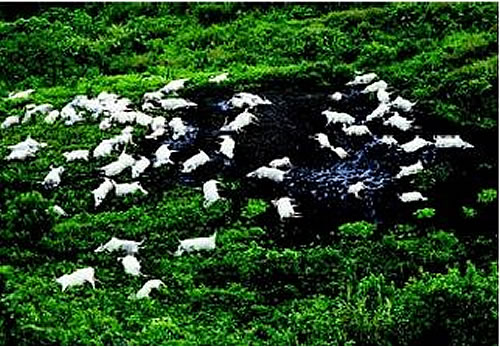As this region of Africa has been subject to rifting the area was volcanic. Lake Nyos is a crater lake that appears to have gas rising out of the magma from below the crater. While the volcano is considered to be inactive, there is a large pool of magma below it. On 1987 triggered by either an earthquake or landslide, a large volume of carbon dioxide and sulphur oxides. to be released from the lake. The analogy could be thought of a stirring a glass of Coke with a spoon. In the surrounding villages, 1700 people and their livestock died. One of the few survivors said that even the flies that normally come to a body were dead as well.

Subsequent analysis of the lake found that is extremely high in dissolved carbon dioxide due to its depth (up to 200 meters). Since then efforts have been underway to degas the lake so that this does not happen again.
The pipe is near the bottom and the pressure of the dissolved gases forcing themselves up the pipe is strong enough to cause a plume of water and gas at the surface.

Lahars - Amero (1985)
The town of Amero had a population of approximately 30,000 in 1985. When the volcano Nevada del Ruis had a small eruption on 13th November 1985, it instantly melted a portion of the glacier that sat on the top of the mountain. The huge volume of water combined with the loose ash on the sides of the mountain, and raced towards the town of Amero.

Nearly all the town was affected and 23,000 perished. The town could have been evacuated but volcano was obscured by clouds and the government were reluctant to evacuate due to pressure from locals concerned about their property values.

The town has essentially been abandoned and 20,000 were left displaced from the event. The area has been left with volcanic mud that has set like concrete. Nearly all those who were buried were left there. Given time this area will become fertile farming land as it was before, but it could still be prone to future lahars.
No comments:
Post a Comment